Great Science Fiction Films
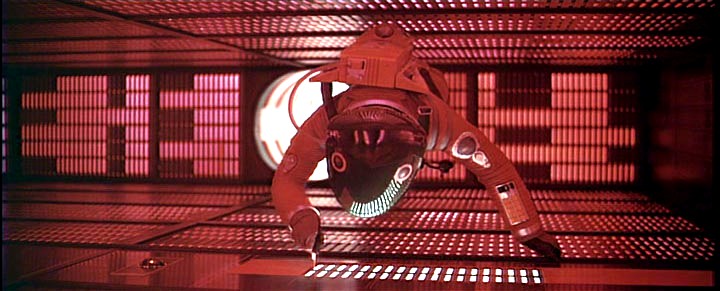
What makes a great science fiction film? Many such films make wild leaps of technological innovation far removed from the scientific reality of today. I can still recall being overwhelmed by the sheer spectacle and pace of Star Wars on my first visit to a large London cinema in 1978. But in spite of my affection for this film as a memento of my teenage years, and enjoying toy light sabre battles with my three sons to this day, I don’t regard it as an original science fiction film. It’s an amalgam of the Battle of Britain and the Dambusters with a touching story of an old man and a young hero thrown in.
A great science fiction film should contain an original story which fleshes out at least one premise of scientific possibility, challenges the viewer to reflect and is entertaining. So here are a few such films which made an impression on me.
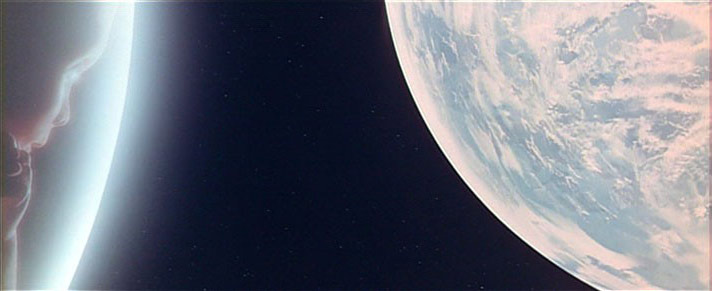
2001:A Space Odyssey (Directed by Stanley Kubrick, released in 1968) The plot of Arthur C. Clarke’s book is based on the idea that a technologically advanced civilisation is responsible for the evolution of man from the apes. The creatures of this civilisation are never seen, but are represented by a strange, ambiguous black monolith that either appears or is found at certain points in earth’s history. The film does not explain why the monolith exerts this influence, lending a sense of mystery and menace to the story.
The film begins with a long, slow-paced sequence set amongst a group of ape-like ancestors of mankind several million years ago. During a conflict between two tribes, the sudden appearance of the monolith triggers one of the apes to begin using a bone as a weapon to kill another ape from a different tribe. The victorious creature throws the bone into the air and the viewer is shocked by the sudden cut from the revolving bone to a revolving spaceship high above the earth, engaged in a celestial dance with satellites and space stations accompanied by a Strauss waltz as the clock moves forward to the early 1990s.
A team of scientists has unearthed a black monolith on the moon, with a completely unknown composition, and of unknown age. The object emits a strong signal directed towards Jupiter, which results in a manned spaceship, the Discovery being built and sent there on an expedition 10 years later to investigate. The remainder of the film is devoted to the fate of the spaceship and crew, and in particular one of the astronauts, Frank Bowman, who ends up undertaking an extraordinary journey, both physically and psychologically.
The film is pedestrian-paced compared to recent films such as The Matrix but is all the more compelling for it. The visual effects are still impressive 40 years on, and were decades ahead of their time. In spite of its U certificate, the film conveys the silence, beauty and menace of what it must be like to be isolated in space, epitomised by the laboured breathing of the astronaut as he tries to break back into the spaceship to shut down the murderous renegade supercomputer Hal, which has taken over control of the Discovery. The final section of the film, where the sole surviving astronaut Frank Bowman is transported through an alien portal to other worlds, to finally become a giant child-like being is bravely and deliberately left open for the viewer to interpret.
Forbidden Planet (Directed by Frank Wilcox 1956) This film has an original central premise – that a machine can create monsters out of people’s innermost desires. A spaceship lands on a remote planet, Altair 4 in response to a distress signal. The visiting crew discover two remaining survivors from another spaceship, the Bellerophon, which crashed there several years earlier. Dr. Morbius, the expedition’s philologist and his beautiful daughter, Altaira. The remainder of the crew were apparently killed by an unknown force when trying to leave the planet. Morbius has discovered a laboratory belonging to an ancient civilisation, the Krell, who were wiped out in a single night of violence over 200,000 years earlier. He has been able to use some of their advanced technology to build a robot and a technologically advanced home, although it is unclear how he has managed to learn and understand it.
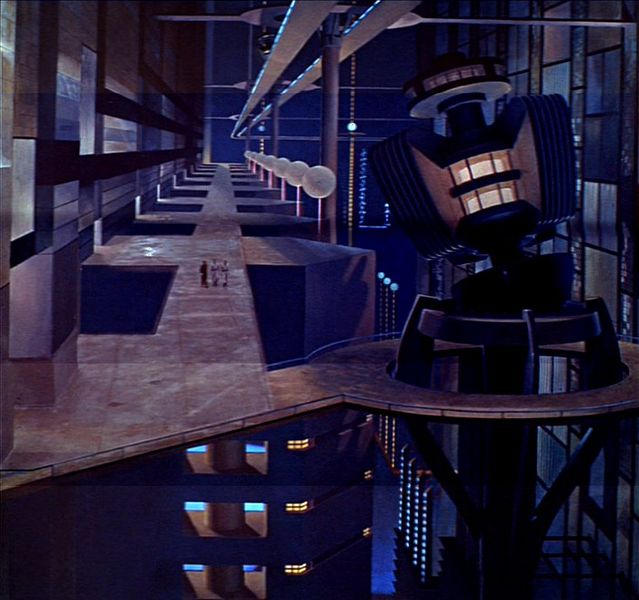
The visitors are shown the spectacular, intact subterranean workings of a gigantic Krell machine, which appears to be self-maintaining, but with no clear purpose. When the commander of the visiting spaceship falls in love with Morbius’s daughter, this triggers an escalating series of attacks on the crew by an invisible creature. It transpires that Morbius has increased his own intelligence using a Krell device, but in doing so he unwittingly connects himself to the subterranean machine which with limitless power unleashes the “monster” of his inner protectiveness towards his daughter, which will kill anyone who poses a threat to their separation.
There is a rapid escalation of suspense during the monster’s attacks, especially in one scene where giant footprints appear in the dust but the monster remains invisible.
The special effects and artwork were as revolutionary for their time as those for 2001. The film has a memorable Shakespearean tragedy of an ending.
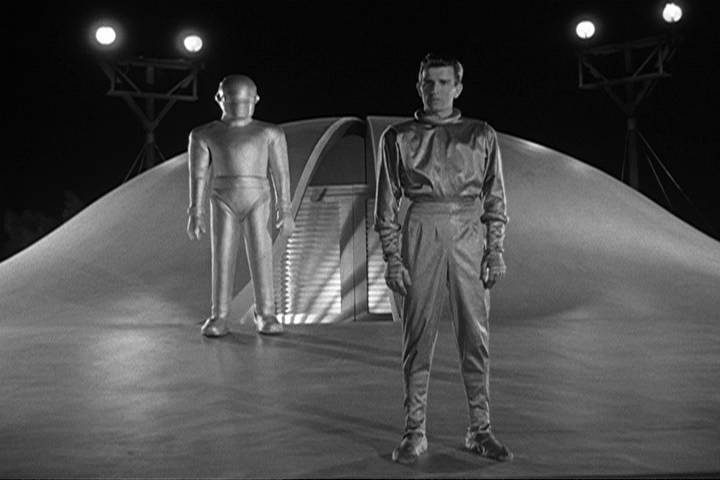
The Day the Earth Stood Still (Directed by Robert Wise, 1951) Initially this film might appear to follow the trend for “popcorn” flying saucer films of the 1950s but it is not typical of the genre. It depicts the events when an alien spaceship lands in Washington DC and a humanoid alien, Klaatu, played by Micheal Rennie, emerges to warn world leaders of the perils of nuclear power. From the start, Klaatu’s intentions are misunderstood by the military and government who are suspicious that he is not genuine, even that it is a Soviet conspiracy (a clear reflection of the Cold War paranoia of the time).
Eventually, Klaatu is asked to demonstrate his powers, and does so by shutting down every electrical device across the world for one hour (excluding hospitals and other critical areas of infrastructure). The film has a bleak ending, with Klaatu being shot by the military, only to be brought back to life by his gigantic silent robot accomplice, Gortt. Klaatu’s final message before leaving the earth – that mankind will be destroyed by outside forces if it cannot live peacefully is sobering and outspoken given the McCarthy era in which it was made. Micheal Rennie exudes an other worldly aura as the lone and lonely alien.
The Terminator (Directed by James Cameron, 1984) This is an exciting and frightening film, with a brilliantly written story. An indestructible humanoid robot (known as a terminator) is sent back in time to present-day Los Angeles to assassinate the mother of the future leader of the human resistance in a war against a world-wide army of computers and machines. The resistance send back one of their soldiers to protect the woman. The contrast between the two time travellers is clear – contrasting the monosyllabic, cold and unflinching terminator (memorably played by Arnold Schwarzenegger) with the more vulnerable but resourceful and brave human soldier Kyle (played by Micheal Biehn).
But the human soldier has two other battles on his hands. Firstly to persuade the young woman, (feistily played by Linda Hamilton) who has an ordinary life in the city that she is the mother of a future leader and of the inevitability of war. Secondly, he has to try and persuade the police about the threat from the terminator. It is only when the terminator attacks the police station and single-handedly wipes out the entire police force that Kyle’s story is vindicated.
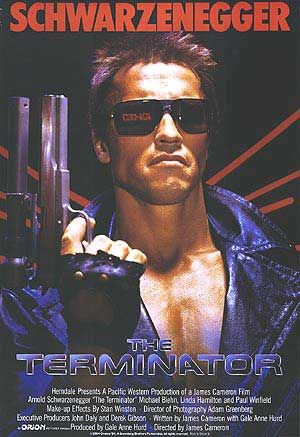
The climactic battle with the relentless terminator is thrilling and the loose ends of the story are tied up ingeniously in a seeming paradox (the future leader sends back his own father to ensure that he survives) to connect with events in the future.
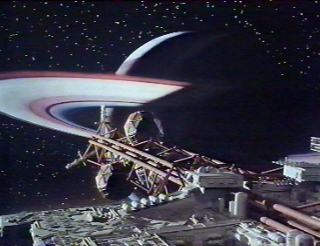
Silent Running (Directed by Douglas Trumbull, 1972) A prescient film given the increased awareness of environmental damage and global warming today, it is set in a future when all vegetation on the earth has been destroyed. The only remaining trees and plants are maintained in gigantic biospheres attached to spaceships travelling through the solar system. The plants are tended by a small human crew and a number of robot gardeners. When the order comes to destroy the remaining biospheres, the captain of one of the vessels, laconically played by Bruce Dern, disobeys orders and attempts to escape with the biospheres.
There is a slow build-up of tension as the rogue spaceship is gradually caught by the authorities. The isolation and despair of the central character is clearly conveyed, and he represents the conscience of humanity, eventually having to make a critical choice to protect the legacy of the earth. It is many years since I watched this film but it made a lasting impression on me.
The Matrix (Directed by Andy and Larry Wachowski, 1999) A spectacular adventure, which used ground-breaking frozen time effects, the Matrix again involves one man going on a journey of discovery. This time, the hero is a computer programmer, Neo (played by a taciturn Keanu Reeves), who has a nagging doubt about the reality of his life. When he begins to receive emails asking about the Matrix, he makes contact with a mysterious group of people led by the enigmatic Morpheus (Lauwrence Fishburne). Neo is given a choice to know the truth about the human condition. When he agrees to find out, he is confronted by a shocking reality – that what he perceived to be his life was imagined. In fact he has been maintained unconscious, along with millions of other humans by a network of computers, and The Matrix is a programme simulating modern-day life which is played for the sleeping masses. The machines use the energy from humans for their own maintenance.
Neo has been identified as the person who has a power to overcome the authority of The Matrix, and the sentient programme which rules it – personified by Agent Smith, an embodiment of sneering evil. The film then follows Neo’s journey of self-discovery, culminating in a jaw-dropping series of battle scenes involving martial arts and bullets before he finds a way to transcend violence. The film deserves a more detailed review of its own.

Alien (Directed by Ridley Scott, 1979). Considered by many to be the definitive space horror film, this is a battle of survival between a small group of humans and a silent, cannibalistic predatory creature which the crew unwittingly brings into their spaceship when they visit a deserted planet in response to a distress call. The film added some fresh ingredients to the genre, including a resourceful female heroic lead, memorably portrayed by Sigourney Weaver, a conspiracy sub-plot (the company owning the spaceship knows about the alien and is prepared to sacrifice the crew to bring the new species back to earth), a hideous and terrifying alien and the use of technology as mundane to some memorably contrived but undeniably well-made and frightening scenes of a “look behind you” nature. Apart from the infamous scene where the creature explodes from John Hurt's stomach (his fellow actors look shocked, as well they might because they weren't told what was going to happen beforehand), the suspense builds inexorably, most memorably when the crew can see on a monitor that something is moving towards one of their colleagues in a series of tunnels but he can't see or hear anything.
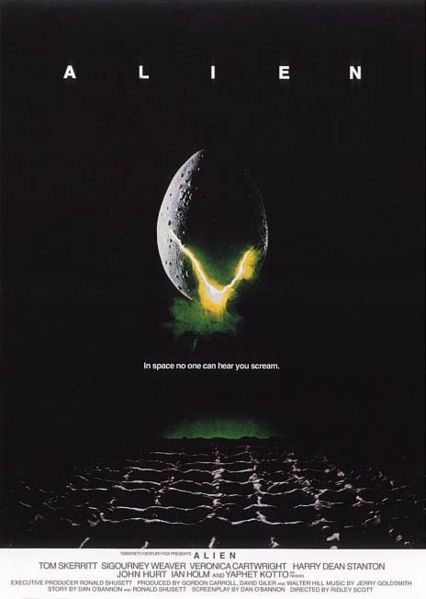
I’m sure many readers will disagree with my selection, but what do you think?
Geoff Butts
